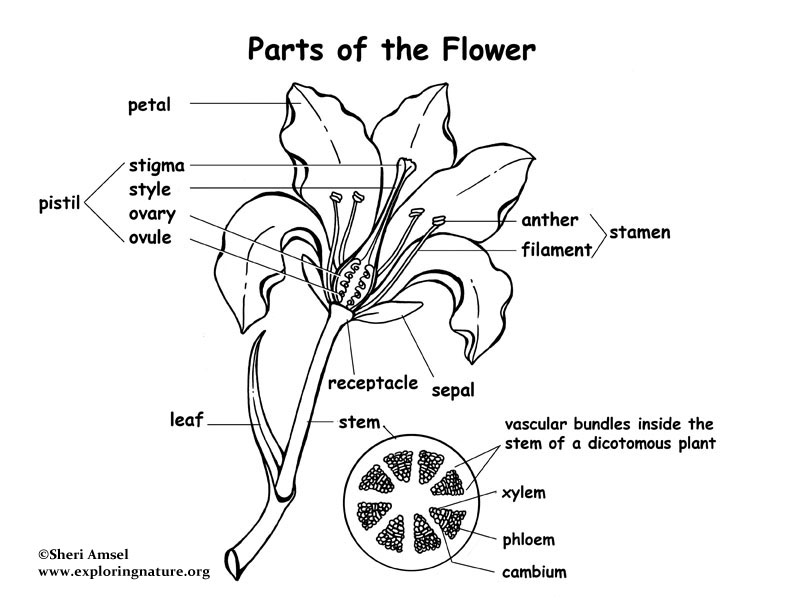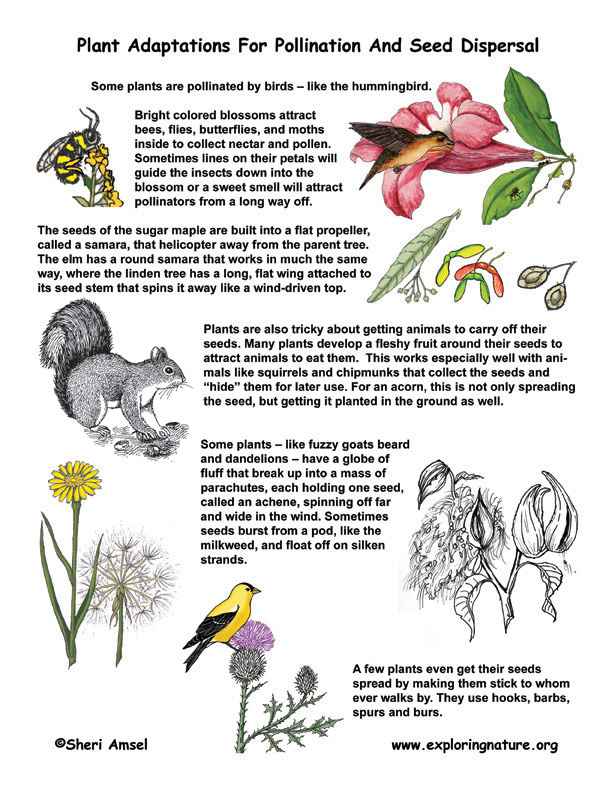

Focus Questions:
1. What adaptations have flowering plants developed to help with pollination?
2. What adaptations have flowering plants developed to help with seed dispersal?
3. How have some plants adapted their reproductive traits to animal behaviors?
Reading:
Plants are so important because they make their own energy from sunlight through photosynthesis. They are at the bottom of the food web, supplying food and energy for all other life on Earth. Plant reproduction is aided by the plant’s flowers that are designed to attract pollinators. The flower has several adaptations for this purpose, including bright colors, showy petals, a sweet scents and even lines on the petals to attract pollinators inside.
The reproductive organs of the plant are inside the flower – the male stamens and the female pistil. The stamen includes an anther on top where the pollen grains (haploid) are made. A long filament holds the anther up to meet the wind or pollinating insect.
The female pistil has 3 parts. The stigma is the sticky tip where pollen grains stick. The ovary is at the base of the pistil and contains the ovules. The style is the thin stalk that connects the stigma down to the ovary.
When fertilized, the ovules become the plants seeds. Many plants develop a fleshy fruit around their seeds to attract animals to eat them. The seeds are spit out nearby or can survive the animal’s digestive tract. When they are “deposited” at the other end, they will sprout into seedlings. Plants like apples, pears, raspberries, and many, many others use this trick to get animals to help disperse their seeds. This works especially well with animals like squirrels and chipmunks that collect the seeds and “hide” them for later use. For an acorn, this is not only spreading the seed, but getting it planted in the ground as well.
Not all plants produce seeds inside a fleshy fruit. The seeds of the sugar maple are built into a flat propeller, called a samara, that helicopter away from the parent tree. The elm has a round samara that works in much the same way, where the linden tree has a long, flat wing attached to its seed stem that spins it away like a wind-driven top. Some plants – like fuzzy goats beard and dandelions – have a globe of fluff that break up into a mass of parachutes, each holding one seed, called an achene, spinning off far and wide in the wind. Sometimes seeds burst from a pod, like the milkweed, and float off on silken strands. Fluffy seeds burst off the rod-like head of a cattail too – each spike releasing a million seeds. Even the giant cottonwoods release seeds attached to a tuft of fluff to float away on the breeze. A few seeds are carried by water, like the mango or coconut. Others spread their seeds explosively with catapulting seedpods – like jewelweed.
A few plants even get their seeds spread by making them stick to whom ever walks by. They use hooks, barbs, spurs and burs. You have probably seen the seeds of cockleburs, beggar’s-ticks, or burdocks stuck in your dogs’ fur or even on your own socks. Even many grasses, like foxtail barley and bur-grass, have hooked seeds.
Plant adaptations for pollination and seed dispersal makes for a fascinating look at form and function.
Look at the seed dispersal model and see if you can identify on which form of seed dispersal each plant depends.
Testing:
Assess plant reproduction content comprehension with the Mutiple Choice Test.
Assess plant reproduction vocabulary comprehension with the labeling page below.


